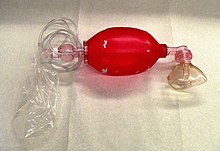Resuscitator
The resuscitator is an aid for manual ventilation of patients with respiratory arrest or insufficient (insufficient) breathing. It consists of a hollow body that has to be compressed for ventilation and a valve with a standardized attachment piece for the ventilation mask or a tube .
The resuscitator was developed in 1956 by Ambu A / S in collaboration with the Danish anesthetist Henning Ruben.
The breathing bag with a non- rebreathing valve (and mask) is therefore also commonly referred to as a Ruben bag or Ambu bag (also called Ambu Resuscitator ). In contrast to the two-layer bag made by Ambu with a foam structure, the manufacturers Laerdal and Kendall have also developed single-layer resuscitation bags.
application

For ventilation, the resuscitator is connected to the patient either with a respiratory mask, which is held with the C-handle , or via an endotracheal tube or a tracheal cannula, and the bag is compressed. The air contained in the hollow body flows through the patient valve into the patient's lungs . When the bag is relaxed again, it automatically refills with air via the inlet valve, and the patient's exhaled air escapes into the environment via the patient valve. It is a semi-open breathing system that allows both spontaneous breathing and assisted or controlled ventilation. The resuscitator is a simple aid for ventilation and does not depend on technical energy sources. It is used in emergency situations and when transporting ventilated patients. In terms of redundancy , it is available as a reserve device wherever patients are mechanically ventilated. To reduce the risk of gastric distension, excessive ventilation pressure must be avoided, as otherwise stomach contents can enter the trachea via the esophagus .
Resuscitators and masks are made in various sizes and shapes so that they can be used on infants, children and adults. With a product from the medical device manufacturer Weinmann, it is possible to vary the tidal volume by turning the ventilation bag and using a “pediatric recessed grip” . Only one bag is needed for adults and children.
To protect the valve from contamination and germs, a ventilation filter (HME filter) can be used, which is inserted between the mask or tube and the patient valve. However, the so-called dead space is increased by approx. 45–95 ml, which can be compensated for by deeper ventilation.
For medical laypeople and people without a ventilation routine, ventilation aids exist that are easier to use.
equipment
Since ventilation in emergencies should usually be carried out with as high a proportion of oxygen as possible, almost all ventilation bags can be connected to an oxygen source. An additional reservoir bag, if it is supplied with an oxygen flow of 10 liters per minute, or a demand valve enable ventilation with an oxygen content of 80 to 100%. Most resuscitators also allow PEEP ventilation. The valve required for this is either permanently installed or can be attached to the expiratory limb of the patient valve. It has the effect that positive pressure remains on the airways even after the exhalation phase. PEEP ventilation can improve oxygen uptake. However, with mask ventilation it increases the risk of gastric overinflation with regurgitation and subsequent aspiration . In particular, resuscitators in child sizes often have a safety valve to prevent ventilation with excessive pressure. Some bags in disaster control units have adapters for respiratory protection filters so that ventilation with ambient air can also take place in a toxic atmosphere.
Disposable and reusable systems
There are now a large number of "disposable" ventilation bags available that are disposed of after use on the patient. The common resuscitation bags from the various manufacturers are usually intended for multiple use and can therefore be disinfected , sterilized and autoclaved , so that hygiene is also taken into account with these models.
Others
The synonyms ambu bags or ruben bags are also used for resuscitation bags . The best-known manufacturer of the bags is the Danish company Ambu A / S , founded in 1937 by the German engineer Holger Hesse. Together with this, the Danish anesthetist Henning Ruben developed the first resuscitator. A strike by Danish truck drivers that cut off the supply of hospitals with the necessary materials and interrupted the supply of oxygen was the trigger for Ruben in 1954 to build the first self-expanding resuscitator. Initially assembled with the help of bicycle spokes, the device became the prototype of what the American Medical Association described in 1964 as one of the most important advances in anesthesia of the past 25 years.
literature
- Sigrid Schäfer u. a .: Specialist care ventilation. Elsevier, Urban & Fischer Verlag, Munich 2008, ISBN 978-3-437-25183-2 , pp. 46-49.
- Walied Abdulla: Interdisciplinary Intensive Care Medicine. Urban & Fischer, Munich a. a. 1999, ISBN 3-437-41410-0 , p. 11 f.
Web links
Individual evidence
- ↑ https://www.ambu.com/about/about-ambu/our-history
- ^ Rescue magazine, Ebner-Verlag, 4/2009
- ↑ Thomas Ziegenfuß: Emergency Medicine. Springer Verlag, Heidelberg 2007, ISBN 978-3-540-48633-6 , p. 101.
- ^ Lothar Ullrich u. a .: Thiemes intensive care and anesthesia with DVD. Georg Thieme Verlag, Stuttgart 2006, ISBN 978-3-13-130910-5 , p. 119.
- ^ Jörg Brokmann: Emergency Medicine Review. To prepare for the "Emergency Medicine" exam. Springer Verlag, Heidelberg 2008, ISBN 978-3-540-33702-7 , p. 96 f.
- ↑ Historical data . ambu.de. Retrieved August 7, 2011.
- ↑ John Zorab: Henning Ruben. In: British Medical Journal. Volume 330 (7482); January 8, 2005 PMC 543884 (free full text).



